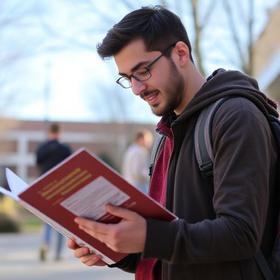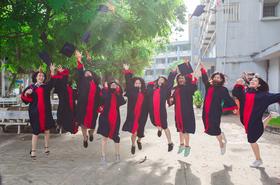- The mission of St. Petersburg College is to provide accessible, open door, learner-centered education for students pursuing associate degrees, limited four year degrees, technical education, and continuing education within Pinellas County and globally, in program areas where the college has special expertise. As a comprehensive multi-campus state college, SPC seeks to be a creative leader and partner with students, communities and other educational institutions to deliver enriched learning experiences and to promote economic development.
School Highlights
St Petersburg College serves 31,506 students (35% of students are full-time).
The college's student-teacher ratio of 18:1 is lower than the state community college average of 20:1.
Minority enrollment is 43% of the student body (majority Hispanic), which is less than the state average of 67%.
Quick Facts (2025-26)
- Enrollment: 31,506 students
- In-state tuition: $3,292
- Out-state tuition: $11,524
- Student-teacher ratio: 18:1
- Minority enrollment: 43%
- Source: Integrated Postsecondary Education Data System (IPEDS)
Top Rankings
St Petersburg College ranks among the top 20% of public schools in Florida for:
Category
Attribute
Community Size
School Overview
The teacher population of 1,795 teachers has stayed relatively flat over five years.
St Petersburg College
(FL) Community College Avg.
Carnegie Classification
Baccalaureate/Associate's Colleges: Mixed Baccalaureate/Associate's
Not applicable, not in Carnegie universe (not accredited or nondegree-granting)
Institution Level
Four or more years
At least 2 but less than 4 years
Institution Control
Public
Private, for profit
Total Faculty
1,795 staff
188 staff
School Calendar
Student Body
The student population of St Petersburg College has grown by 9% over five years.
The student-teacher ratio of 18:1 has increased from 15:1 over five years.
The St Petersburg College diversity score of 0.62 is less than the state average of 0.75. The school's diversity has stayed relatively flat over five years.
Total Enrollment
31,506 students
1,236 students
Student-Teacher Ratio
18:1
20:1
# Full-Time Students
10,893 students
588 students
# Part-Time Students
20,613 students
648 students
# Enrollment Undergraduate
315 students
282 students
# Full-Time Undergraduate Students
10,893 students
587 students
# Full-Time Graduate Students
n/a
295 students
# Part-Time Undergraduate Students
20,613 students
832 students
# Part-Time Graduate Students
n/a
58 students
Total Dormitory Capacity
n/a
174 students
% American Indian/Alaskan
n/a
n/a
% Asian
4%
5%
% Hispanic
18%
31%
% Black
13%
19%
% White
57%
33%
% Hawaiian
n/a
2%
% Two or more races
4%
4%
% Non Resident races
1%
3%
% Unknown races
2%
3%
Diversity Score
0.62
0.75
College Completion Rate (Students who graduate in less than 4 years)
n/a
63%
College Completion Rate (Students who graduate in 4 years or more than 4 years)
38%
43%
Average Graduate Earnings (10 Years)
$35,300
$31,500
Tuition and Acceptance Rate
The public in-state tuition of $3,292 is less than the state average of $4,761. The in-state tuition has grown by 22% over four years.
The public out-state tuition of $11,524 is more than the state average of $11,352. The out-state tuition has grown by 24% over four years.
In-State Tuition Fees
$3,292
$4,761
Out-State Tuition Fees
$11,524
$11,352
% Students Receiving Some Financial Aid
71%
86%
Median Debt for Graduates
$17,443
$9,750
Median Debt for Dropouts
$9,113
$5,500
Acceptance Rate
n/a
94%
SAT Reading
n/a
442
SAT Math
n/a
429
ACT Composite
n/a
18
ACT English
n/a
18
ACT Math
n/a
18
Source: 2024 (or latest year available) Integrated Postsecondary Education Data System (IPEDS) , School Administrators
School Notes
- The mission of St. Petersburg College is to provide accessible, open door, learner-centered education for students pursuing associate degrees, limited four year degrees, technical education, and continuing education within Pinellas County and globally, in program areas where the college has special expertise. As a comprehensive multi-campus state college, SPC seeks to be a creative leader and partner with students, communities and other educational institutions to deliver enriched learning experiences and to promote economic development. St. Petersburg College is located in St. Petersburg, Florida, in the heart of the Tampa Bay area. The city of St. Petersburg is bordered by 234 miles of shoreline, surrounded by water on three sides - Tampa Bay to the east and south and the beaches of the Gulf of Mexico to the west. Between its shores, the city has over 130 parks, outstanding recreational facilities, dynamic historical neighborhoods, reputable schools, and thriving small, mid-size and large businesses providing a healthy, fast-growing economy for its residents. The College fulfills its mission led by an outstanding, diverse faculty and staff, and enhanced by advanced technology, distance learning, international education, innovative teaching techniques, an outstanding library and other information resources, continuous institutional self-evaluation, a climate for student success and an enduring commitment to excellence.
Frequently Asked Questions
How much does St Petersburg College cost?
St Petersburg College's tuition is approximately $3,292 for In-State students and $11,524 for Out-State students.
What is St Petersburg College's ranking?
St Petersburg College ranks among the top 20% of community college in Florida for: Largest student body.
Recent Articles

How to Transfer from Community College to a Four-Year University in 2025
A step-by-step guide for community college students transferring to a four-year university in 2025 — updated strategies, data and expert insights.

Scholarships for Community College Students 2025
Explore updated scholarship programs, tuition data, and expert strategies for community college students in 2025.

The Rise of Technical and Vocational Training in 2025
Explore the 2025 surge in technical and vocational training—enrollment, policy, costs, and why this path is gaining ground for students and parents.









